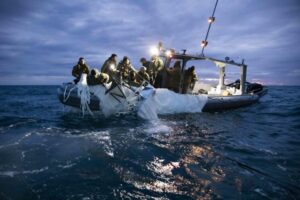The Senate’s top defense appropriator has said he wants the fiscal year 2024 budget to include funding and plans to help the Pentagon avoid future intrusions into U.S. airspace following the recent spate of Chinese surveillance balloon incidents.
Sen. Jon Tester (D-Mont.), chair of the Senate Appropriations Defense Subcommittee, and lawmakers on the panel pressed DoD officials during a hearing Thursday on modernization efforts to bolster airspace detection capabilities and the decision making process related to the tracking and eventual shooting down of the Chinese balloon last week.

“This administration owes Americans answers not only on what happened this past week but on what steps they’re going to take to ensure that this never happens again,” Tester said. “I hope this is addressed in some line item. And not only addressed with dollars but addressed with actions on how these monies will be put to work to make sure that this never happens again.”
Air Force Gen. Glen VanHerck, head of North American Aerospace Defense Command (NORAD) and U.S. Northern Command, told reporters on Monday the Chinese surveillance balloon incidents, to include three such incidents during the Trump presidency and another incursion into U.S. airspace earlier in the Biden administration, have highlighted a “domain awareness gap” (Defense Daily, Feb. 7).
Melissa Dalton, assistant secretary of defense for homeland defense and hemispheric affairs, told the panel DoD is continuing to work with Canada on modernizing NORAD’s surveillance capabilities “paced to the current and future geopolitical environment.”
“As Gen. VanHerck has mentioned, the department continues to be acutely aware of the need to enhance persistent surveillance of the airspace and maritime approaches to North America,” Dalton said.
Dalton cited a near-term focus on working with Canada to augment the current early-warning North Warning System capability with a new set of sensors called Crossbow “that will enhance NORAD’s ability to detect approaching airborne threats.”
The Canadian government has described Crossbow as a “network of sensors with classified capabilities, distributed across Northern Canada, as another layer of detection.”
Longer-term modernization efforts, according to Dalton, include construction of over-the-horizon radars in both the U.S. and Canada to further augment the North Warning System “and enhance NORAD’s ability to perform its airspace warning, control and maritime warning missions.”
Navy Vice Adm. Sara Joyner, director of force structure, resources and assessment for the Joint Staff, J-8, told the panel there are plans in FY ‘23 to continue “significant investments in both the space architecture, which we think is key for future monitoring and understanding of our environment both within the United States and overseas abroad, and undersea as well.”
“Modernization is important. The existing systems can meet our needs. We continue to maintain and invest in maintaining those systems as we modernize,” Joyner said.
The SAC-D panel also pressed the DoD witnesses on the specific timeline for tracking the balloon and how the department would handle such a situation if another Chinese balloon crossed into U.S. airspace.
“By the way, this is going to happen again,” Tester said. “Either this is no big deal in the military’s eyes, and I don’t think you’re going to say that, or there’s not a consistent plan on how to deal with them.”
Dalton noted the balloon was first detected entering into U.S. airspace over Alaska on Jan. 28 and then entered continental U.S. airspace on Jan. 31, and said the benefits of waiting to shoot it down over water on Feb. 4 included having more time to observe the balloon and collect intelligence on its capabilities, refining options to ensure lower risk of debris harm to civilians and improving prospects of debris recovery.
“In determining potential options, the risk of Chinese intelligence collection was deemed to be low to moderate, while the risk to U.S. personnel on the ground was assessed as moderate to significant given the various debris field models combined with potential weaponeering,” Army Lt. Gen. Douglas Sims II, Joint Staff, J-3’s, director for operations, told the panel. “As the assessment of risk to U.S. personnel outweighed the potential intelligence loss, the recommendation was made to shoot the balloon down over an area that minimized the risk to U.S. citizens.”
VanHerck told reporters on Monday the Raytheon Technologies [RTX]-built AIM-9X Sidewinder missile fired from an F-22 fighter aircraft was the safest and most effective option for taking out the balloon after it flew off the coast of South Carolina on Saturday (Defense Daily, Feb. 6).
“This balloon could’ve been shot down, it seems to me, over remote areas in Alaska or our territorial waters surrounding Alaska,” Sen. Susan Collins (R-Maine), the SAC-D vice chair, said during the hearing. “In my judgment, U.S. deterrence was weakened when the spy balloon was permitted to traverse Alaska and several other states, including hovering sensitive military bases and assets.”
Sims said the detection effort indicated the Chinese balloon did not travel over any sensitive sites while moving over Alaska.
“As an Alaskan, I am so angry. I want to use other words but I’m not going to,” Sen. Lisa Murkowski (R-Alaska) said. “It seems to me, the clear message to China is we’ve got free range in Alaska.”
Dalton said the subsequent debris recovery operation factored into the decision calculus over whether to shoot the balloon down over Alaska.
“If we had taken it down over the state of Alaska, which is part of the United States, it would have been a very different recovery operation,” Dalton said. “The water depths offshore the Aleutian [Islands] at six-plus nautical miles go very quickly from about 150 feet to over 18,000 feet near the Bering Sea. The winter water temperatures in the Bering Sea hover consistently in the low 30’s, which would make recovery and salvage operations very dangerous. Additionally, the northern portion of the Bering Sea has ice cover, which can be extremely dangerous [and] which would induce additional risk.”